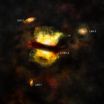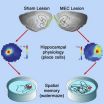(Press-News.org) Nestled among a triplet of young galaxies more than 12.5 billion light-years away is a cosmic powerhouse: a galaxy that is producing stars nearly 1,000 times faster than our own Milky Way. This energetic starburst galaxy, known as AzTEC-3, together with its gang of calmer galaxies may represent the best evidence yet that large galaxies grow from the merger of smaller ones in the early Universe, a process known as hierarchical merging.
An international team of astronomers observed these remarkable objects with the Atacama Large Millimeter/submillimeter Array (ALMA).
"The ALMA data reveal that AzTEC-3 is a very compact, highly disturbed galaxy that is bursting with new stars at close to its theoretically predicted maximum limit and is surrounded by a population of more normal, but also actively star-forming galaxies," said Dominik Riechers, an astronomer and assistant professor at Cornell University in Ithaca, New York, and lead author on a paper published today (Nov. 10) in the Astrophysical Journal. "This particular grouping of galaxies represents an important milestone in the evolution of our Universe: the formation of a galaxy cluster and the early assemblage of large, mature galaxies."
In the early Universe, starburst galaxies like AzTEC-3 were forming new stars at a monstrous pace fueled by the enormous quantities of star-forming material they devoured and by merging with other adolescent galaxies. Over billions of years, these mergers continued, eventually producing the large galaxies and clusters of galaxies we see in the Universe today.
Evidence for this hierarchical model of galaxy evolution has been mounting, but these latest ALMA data show a strikingly clear picture of the all-important first steps along this process when the Universe was only 8 percent of its current age.
"One of the primary science goals of ALMA is the detection and detailed study of galaxies throughout cosmic time," said Chris Carilli, an astronomer with the National Radio Astronomy Observatory in Socorro, New Mexico. "These new observations help us put the pieces together by showing the first steps of a galaxy merger in the early Universe."
AzTEC-3, which is located in the direction of the constellation Sextans, is what astronomers refer to as a submillimeter galaxy, since it shines brightly in that portion of the spectrum, but is remarkably dim at optical and infrared wavelengths. This is due to light from its stars being absorbed by dust in the star-forming environments of the galaxy and then re-emitted by the dust at far-infrared wavelengths. As this light travels across the cosmos, it becomes stretched due to the expansion of the Universe, so by the time it arrives at Earth, the far-infrared light has shifted to the submillimeter/millimeter portion of the spectrum.
ALMA, with its remarkable sensitivity and high resolving power, was able to observe this system at these wavelengths in unprecedented detail. It also was able to study, for the first time, the star-forming gas in three additional, extremely distant members of an emerging galactic protocluster.
The ALMA data revealed that the three smaller, more normal galaxies are indeed producing stars from their gas at a relatively calm and steady pace. Unlike its neighbors, however, AzTEC-3 is burning through star-forming fuel at breakneck speed. Indeed, AzTEC-3 appears to form more new stars each day than our Milky Way galaxy forms in an entire year -- outpacing the normal galaxies in its proximity by about a factor of 100.
The researchers also observed very little rotation in AzTEC-3's dust and gas -- suggesting that something had disrupted its motion. Taken together, these two characteristics are strong indications that AzTEC-3 recently merged with another galaxy.
"AzTEC-3 is currently undergoing an extreme, but short-lived event," said Riechers. "This is perhaps the most violent phase in its evolution, leading to a star formation activity level that is very rare at its cosmic epoch."
The astronomers believe that AzTEC-3 and the other nearby galaxies appear to be part of the same system, but are not yet gravitationally bound into a clearly defined cluster. This is why the astronomers refer to them collectively as a protocluster.
The starburst galaxy was originally observed with and named after the AzTEC millimeter-wavelength camera, which was installed at the time on the James Clerk Maxwell Telescope, a single-dish radio telescope located on Mauna Kea, Hawaii. Only with ALMA has it become possible to understand the nature of this exceptional galaxy and those in its immediate environment.
INFORMATION:
The paper [Dominik A. Riechers et al. 2014 ApJ 796 84] is published here:
http://iopscience.iop.org/0004-637X/796/2/84/article
The National Radio Astronomy Observatory is a facility of the National Science Foundation, operated under cooperative agreement by Associated Universities, Inc.
The Atacama Large Millimeter/submillimeter Array (ALMA), an international astronomy facility, is a partnership of Europe, North America and East Asia in cooperation with the Republic of Chile. ALMA is funded in Europe by the European Southern Observatory (ESO), in North America by the U.S. National Science Foundation (NSF) in cooperation with the National Research Council of Canada (NRC) and the National Science Council of Taiwan (NSC) and in East Asia by the National Institutes of Natural Sciences (NINS) of Japan in cooperation with the Academia Sinica (AS) in Taiwan. ALMA construction and operations are led on behalf of Europe by ESO, on behalf of North America by the National Radio Astronomy Observatory (NRAO), which is managed by Associated Universities, Inc. (AUI) and on behalf of East Asia by the National Astronomical Observatory of Japan (NAOJ). The Joint ALMA Observatory (JAO) provides the unified leadership and management of the construction, commissioning and operation of ALMA.
VIDEO:
Dartmouth researchers say lung cancer screening in the National Lung Screening Trial meets a commonly accepted standard for cost effectiveness as reported in the Nov. 6 issue of the New...
Click here for more information.
Dartmouth researchers say lung cancer screening in the National Lung Screening Trial (NLST) meets a commonly accepted standard for cost effectiveness as reported in the Nov. 6 issue of the New England Journal of Medicine. This relatively new screening ...
Imagine being able to recognize your car as your own but never being able to remember where you parked it. Researchers at University of California, San Diego School of Medicine have induced this all-too-common human experience - or a close version of it - permanently in rats and from what is observed perhaps derive clues about why strokes and Alzheimer's disease can destroy a person's sense of direction.
The findings are published online in the current issue of Cell Reports.
Grid cells and other specialized nerve cells in the brain, known as "place cells," comprise ...
Cats and humans have shared the same households for at least 9,000 years, but we still know very little about how our feline friends became domesticated. An analysis of the cat genome by researchers at Washington University School of Medicine in St. Louis reveals some surprising clues.
The research appears Nov. 10 in the Proceedings of the National Academy of Sciences Early Edition.
Cats have a relatively recent history of domestication compared with dogs; canines arose from wolves over 30,000 years ago.
"Cats, unlike dogs, are really only semidomesticated," said ...
A massive new University of Colorado Boulder study indicates there is a statistical link between hotter temperatures generated by climate change and the risk of armed conflicts in sub-Saharan Africa.
CU-Boulder Professor John O'Loughlin led a research team that assessed more than 78,000 armed conflicts between 1980 and 2012 in the Sahel region of Africa - a semi-arid belt just south of the Saharan Desert that spans about 3,000 miles and more than a dozen countries from the Atlantic to the Indian oceans.
The team was looking for links between armed conflicts and temperature ...
HOUSTON - (Nov. 10, 2014) - An analysis of more than 100 health insurance plans across Texas offered under the Affordable Care Act (ACA) shows that plans can differ significantly in premium cost and the number of hospitals included in insurance networks. That's just one of the findings of a report released today by the Episcopal Health Foundation and Rice University's Baker Institute for Public Policy.
The report examined "Silver" health insurance plans offered by insurers within the ACA's Marketplace. Texas is divided into 26 different geographic areas, with different ...
Philadelphia, PA, November 10, 2014 - Beta-blockers have been a cornerstone in the treatment of heart attack survivors for more than a quarter of a century. However, many of the data predate contemporary medical therapy such as reperfusion, statins, and antiplatelet agents, and recent data have called the role of beta-blockers into question. Two new studies published in The American Journal of Medicine evaluated the traditional management of these patients after their discharge from the hospital and in the light of changing medical treatment, as well as the impact of the ...
The adult human body is made up of about 37 trillion cells. Microbes, mainly bacteria, outnumber body cells by 10 to 1. Increasingly, scientists recognize that this huge community of microbes, called the microbiome, affects the health, development and evolution of all multicellular organisms, including humans.
Studies show symbiotic microbes can help prevent infection by disease-causing pathogens. But sometimes the interaction goes the other way, with a pathogen or disease disrupting the normal community of symbiotic bacteria. In a new study, a team of scientists from ...
ANN ARBOR--In a step toward robots smaller than a grain of sand, University of Michigan researchers have shown how chains of self-assembling particles could serve as electrically activated muscles in the tiny machines.
So-called microbots would be handy in many areas, particularly medicine and manufacturing. But several challenges lie between current technologies and science fiction possibilities. Two of the big ones are building the 'bots and making them mobile.
"We are inspired by ideas of microscopic robots," said Michael Solomon, a professor of chemical engineering. ...
BUFFALO, N.Y. - Most people rarely sing publicly outside of a duty-bound rendition of "Happy Birthday." And since that particular song is usually offered as a group performance, even the reluctant join in the spirit of the occasion, hoping their individual shortcomings will be cloaked by the chorus.
"I can't sing," says the hesitant performer. But a University at Buffalo psychologist believes that most people are not as bad at singing as they might think and he is collaborating on the development of an online test that will evaluate participants' ability to match specific ...
Boulder, Colo. -- Nov. 10, 2014 -- When the double asteroid Patroclus-Menoetius passed directly in front of a star on the night of Oct. 20, a team of volunteer astronomers across the U.S. was waiting.
Observing the event, known as an occultation, from multiple sites where each observer recorded the precise time the star was obscured, yielded the first accurate determination of the two objects' size and shape. The analysis was led by Dr. Marc W. Buie, staff scientist in Southwest Research Institute's (SwRI) Space Studies Department in Boulder, Colo.
The team effort was ...



